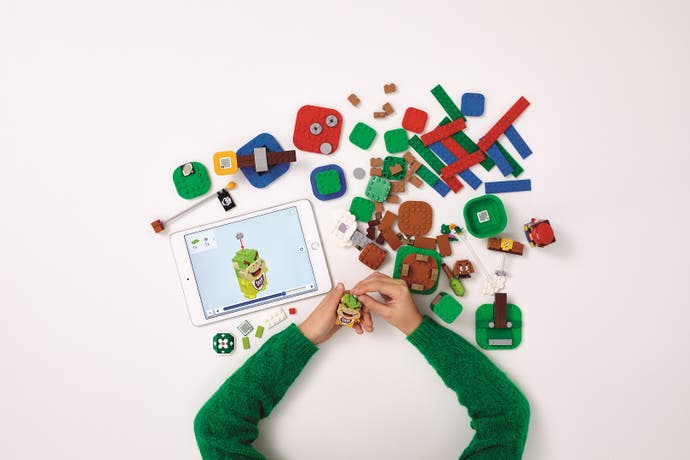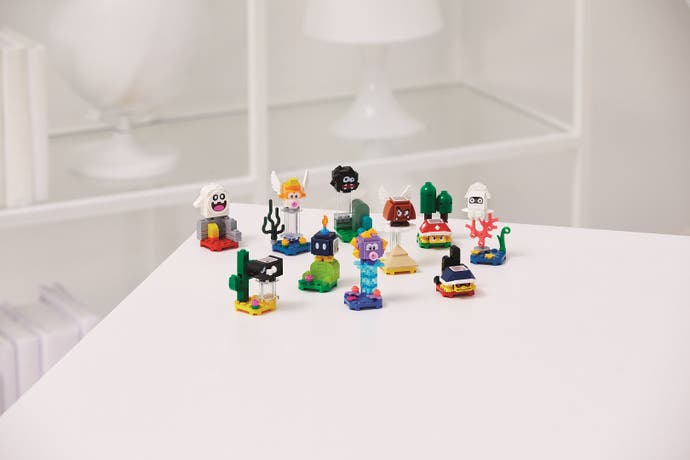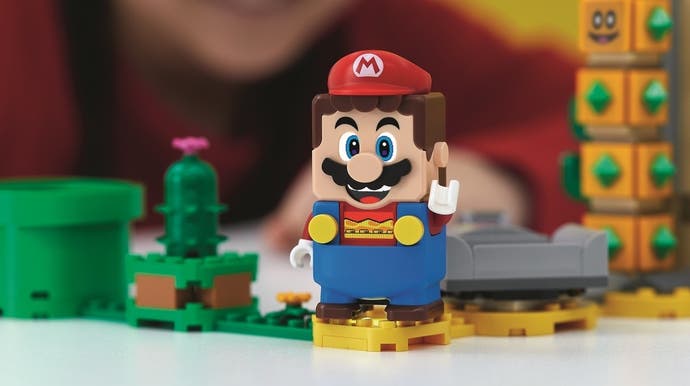Two of the world's great toymakers meet in the middle with Lego Super Mario
Question brick.
Few companies can claim to have had as great an influence on the last 50 years of childhood as Nintendo and Lego. These are not just two titanic brands, both famous for their fearsome quality control. They also represent two deeply thought-out and consistently developed philosophies of play. So any collaboration between them is consequential indeed, and here it is: the Lego Super Mario toy range, which arrives in shops today.
I've had a selection from the range to play with for the past couple of weeks. It's fascinating stuff. The sets, the interactive Mario figure and the accompanying app work hard to combine the best and most fondly held characteristics of both Lego construction sets and Super Mario games. If it doesn't quite come off, it's only because these two creations - each of which can legitimately be considered among the greatest works of industrial art of the 20th century - are such perfect systems, with such integrity, that they resist any attempt to splice or remix them.
This is no ordinary licensed Lego series. It isn't for fans or collectors, like, say, the Lego Overwatch range - there's the luxurious Lego NES for those folks. It's for kids. But nor does it quite resemble Lego Batman or Lego Star Wars sets, where the fun comes from seeing your favourite characters rendered as minifigures and from building replicas of the famous vehicles and props to play with in dioramas of your own devising.

Mario wouldn't be quite right for this approach, perhaps because his world is so surreal and arbitrary that there isn't the same pleasure to be had from translating something that looks real into Lego's language of bricks. In a way, Mario is already Lego, already modular. You take components - a question block, a goomba, a coin, a platform, a pipe - and combine them to see how they interact. This is why Super Mario Maker works so well: the games were built from construction kits to begin with.
So Lego Super Mario is a modular system that builds into another modular system. Rather than large, complex builds, it offers many small builds that make up the elements of a Mario level: a start pipe, a goal pole, an enemy or block to bop, a platform. You can then assemble these into courses of your own design and have Mario 'run' them. Mario himself, rather than a minifigure, is a battery-powered, interactive chunk of plastic, complete with sensors, a speaker, brightly lit and animated features, and even Bluetooth.
The plumber's iconic plump curves have been squashed into a brick shape, and from the original trailer it was a little hard to understand the appeal. Picking him up is a different matter. He's wonderfully tactile and solid, with just the right amount of heft, and you feel confident bopping, bouncing and smashing him about the place. The interactions are lots of fun. Lie him down and he snores; pull his dungarees off and he squeaks, "Mamma Mia!" My 3-year-old son is a bit too young for the intricacies of the sets, but he responded to Mario immediately.
A colour sensor on the figure's base reads red tiles as lava, green as grass, yellow as sand and blue as water, and Mario yelps or splashes accordingly. It also reads coded tile pieces to interact with the world around him: jump on a Goomba's head for a coin or on a mushroom for a powerup, stand on a platform to trigger a minigame and a little Mario tune. There's something magical about the way the authentic music and sound effects pipe from the little character. Once you've assembled a course, tap Mario on the pipe and you will trigger a 60-second level in which the aim is to earn as many coins as possible and then hit the goal before time runs out. It's frantic fun. The app tracks your records and encourages you to snap a picture of your creation and upload it to share with other players. It's also where you'll find all the building instructions for the sets.
The builds, it must be said, are not the most engaging thing about Lego Super Mario. It's fair enough that they're not too complex - these sets are squarely aimed at kids aged 6 and up - but because they're so modular, you don't have the sense of discovery, satisfaction and even wit that the best Lego builds can articulate as their cunningly layered designs complete in your hands. With Lego Super Mario, you build one small component, turn it over in your hands and smile at it, then move on to the next.

That's true of the starter set, at least. (This set costs about £50 and includes the Mario figure as well as quite a few course elements to play with, including an adorable Bowser Jr.) The two expansion sets I was sent were slightly bigger and more mechanically clever builds. One was a contraption combining a rotating platform with spinning Bullet Bills that might knock Mario off it; the other had a Pokey (one of those toppling, grinning cactus towers) that you could knock down a segment at a time with a little hammer, delightfully. These cost around £20. Expansion sets scale all the way from £9 power-up costumes for Mario (very cute, with interactive features) to a £90 Bowser's castle set. Even by Lego's intimidating standards, this is expensive stuff, and it doesn't feel like the builds compare favourably in value with, say, the wonderful Creator series.
It's heartwarming that Lego and Nintendo have insisted that the Mario toy range should be just that - toys, for kids. It's even inspiring that they have approached it, not as a mere branding opportunity, but as a chance to design a new kind of play that sits somewhere between the precision, tactility and creativity of Lego and the anarchic digital interactions of Super Mario games. The app is slick and the Mario figure is just such a joyful little thing. But, somehow, the end result is not quite Lego, and it's not quite Mario. It's a hybrid - a fascinating and fun one, but one that can only hint at the pure joy of the originals.


